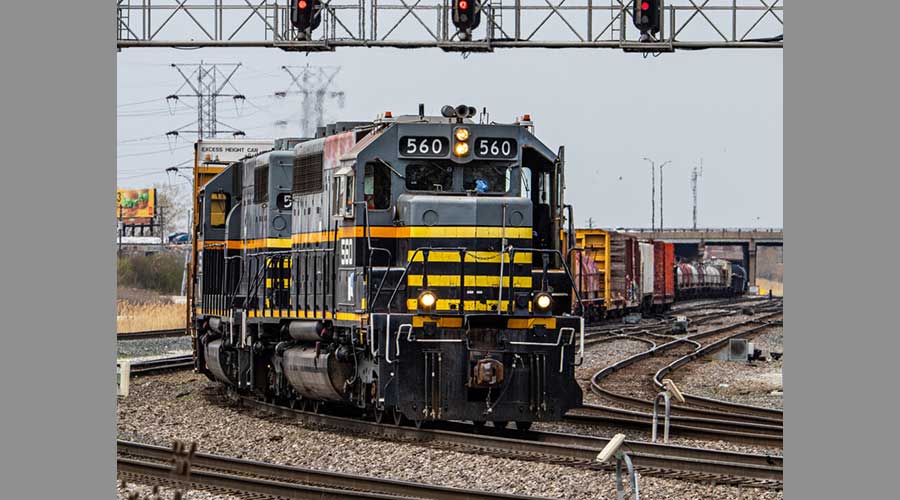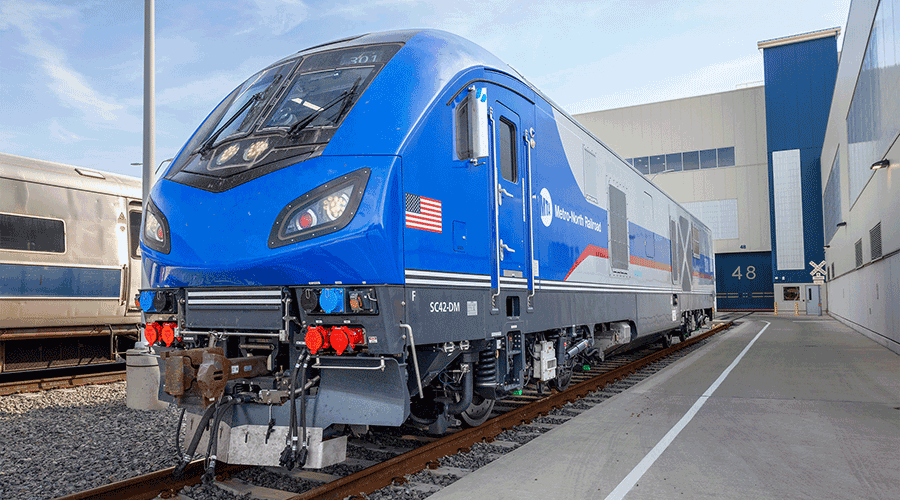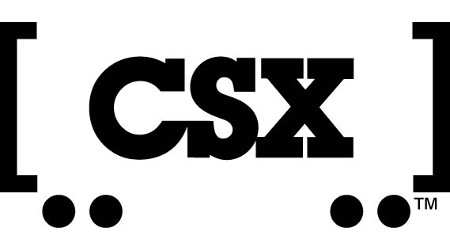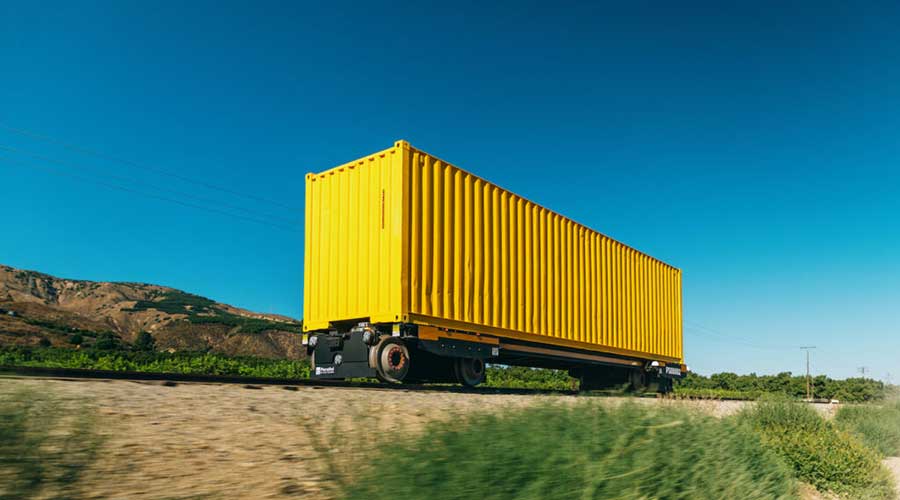Newsletter Sign Up
Stay updated on news, articles and information for the rail industry
Stay updated on news, articles and information for the rail industry
RAIL EMPLOYMENT & NOTICES
Rail News Home
High-Speed Rail
Rail News: High-Speed Rail
2/11/2010
Rail News: High-Speed Rail
APTA/UIC's High Speed Practicum - Chicago: Day Two
advertisement
Day Two of the American Public Transportation Association (APTA)/Union Internationale des Chemins de fer’s (UIC) International Practicum on Implementing High Speed Rail in the United States, held Feb. 10 at the Chicago Hilton, consisted of three sessions focusing on rolling stock, operations and “the market and customers.”
During a three-hour rolling stock seminar, we heard from José Antonio Jiménez-Redondo, director of rolling stock for Spain’s Renfe, Naoto Yanase, deputy director of Japan Railways Group and Kenneth Uznanski, principal officer of fleet planning and partnership policies for Amtrak.
Redondo provided an overview of Renfe’s rolling stock strategy. Among his points:
• Basic requirements to consider when designing new trains include: commercial (number and type of seats, on-board catering and entertainment services, etc.), technical and security (compliance with UIC, railway and national standards), operations and maintenance (compliance with reliability, availability and cleanliness standards), and compatibility with the infrastructure (compatibility with track, catenary, access doors and platforms).
• Journey times should be less than two hours, 30 minutes for a 400-mile trip.
• The rolling stock purchase process can take up to five years and “the cost will get you,” said Redondo — between $700,000 and $1.4 million — and that time and cost should be taken into account when planning for a high-speed system.
• When Renfe created AVE, its high-speed brand, in 1990, officials decided it should focus on its core business — high-speed passenger transport — and subcontract all non-core activities. Under this model, Renfe contracts preventive and corrective maintenance, and exterior and interior cleaning. Among its contract requirements, Renfe has the flexibility to adapt maintenance plans and overhaul activities to meet commercial needs, technical and maintenance support in case of vehicle incidents on track, 24/7 on-call emergency rescue team, vandalism and minor accident repair, and a “quality commitment” under which the maintenance contractor reimburses passengers for their ticket if the train is delayed by more than five minutes.
• Renfe sets its contracts for periods of five to 14 years, which helps the agency set a business plan, since they know what their maintenance costs will be for an extended period of time.
Uznanski discussed Amtrak’s fleet replacement plan, which was released last week, as well as the role the national intercity passenger railroad can play in a U.S. high-speed rail network.
Amtrak partnered with more than 30 states to help advance applications for the first round of high-speed and intercity passenger rail funding under the stimulus bill, and many of those states did receive grant awards, Uznanski said.
He went on to make a case for Amtrak as a high-speed operator. According to Uznanski:
• Amtrak has long-standing relationships with all the major Class Is.
• The railroad currently provides service for 15 state-supported corridors, and hopes to grow that number in the future while also playing a role in the emerging high-speed corridors.
• Examples of successful collaboration between Amtrak and states include they Keystone Corridor between Philadelphia and Harrisburg, Pa., where the state and railroad jointly spent $145 million to upgrade the line and increase train speeds to 110 mph; the Michigan Line between Chicago and Detroit/Pontiac, where Amtrak is working with the Michigan DOT to implement positive train control; and the Northeast Corridor, where Amtrak has upgraded signal systems, eliminated most grade crossings, electrified the line and implemented Acela service, which operates at speeds up to 150 mph.
“We want to be a player and we would seek to operate on any dedicated high-speed rail corridor if funding support is available,” Uznanski said. “We are well-versed in electrified services and operations, and we can provide maintenance, planning and engineering expertise.”
In the meantime, Amtrak is working with a group of 10 states to develop standard specifications for its fleet replacement program. The railroad expects to stretch its fleet program out, procuring new cars at a rate of about 100 per year, to have “a consistent fleet that’s of reasonable commercial age” while also providing an opportunity to develop a strong U.S. manufacturing base, said Uznanski.
During Day Two’s luncheon, Wisconsin Transportation Secretary Frank Busalacchi delivered the keynote address, during which he stressed the importance of keeping the pressure on legislators to continue funding high-speed rail beyond the $8 billion in stimulus funds and $2.5 billion appropriation in the FY2010 federal budget.
“We need a long-term commitment, over a number of years, to not only grow intercity service, but implement high-speed rail,” he said. “But we know we must walk before we can run. We support an incremental approach — there are things we can do now, and quickly, to improve intercity passenger-rail service, and that will complement true high-speed service in the future.”
Other snippets from Day Two’s technical sessions:
• Since Japan’s Shinkansen high-speed train began service in 1964, there have been zero fatalities. The agency has achieved the stellar safety rate in part by eliminating all grade crossings on the corridor, conducting maintenance work solely during time when trains are not operating and running a “detection train” along the line after maintenance work is completed to ensure everything is running smoothly
• Average train delays in Japan are between 0.3 and 0.5 minutes per train.
• People in Japan use high-speed rail because they can easily connect with other public transportation modes.
• The best way to compete with automobile travel is to increase service frequency. In Japan, high-speed trains operate every four minutes during rush hour. Between Paris and Brussels, 28 trains operate each day, with a departure every 30 minutes.
• Since Spain launched its AVE high-speed system, automobile travel has lost more than 40 percent of its market share and air travel has lost more than 60 percent of its market share.
On the final half-day agenda Feb. 11: a session on high-speed economic, financial and managerial considerations, as well as presentations on high-speed projects in the Midwest region.
— Angela Cotey
During a three-hour rolling stock seminar, we heard from José Antonio Jiménez-Redondo, director of rolling stock for Spain’s Renfe, Naoto Yanase, deputy director of Japan Railways Group and Kenneth Uznanski, principal officer of fleet planning and partnership policies for Amtrak.
Redondo provided an overview of Renfe’s rolling stock strategy. Among his points:
• Basic requirements to consider when designing new trains include: commercial (number and type of seats, on-board catering and entertainment services, etc.), technical and security (compliance with UIC, railway and national standards), operations and maintenance (compliance with reliability, availability and cleanliness standards), and compatibility with the infrastructure (compatibility with track, catenary, access doors and platforms).
• Journey times should be less than two hours, 30 minutes for a 400-mile trip.
• The rolling stock purchase process can take up to five years and “the cost will get you,” said Redondo — between $700,000 and $1.4 million — and that time and cost should be taken into account when planning for a high-speed system.
• When Renfe created AVE, its high-speed brand, in 1990, officials decided it should focus on its core business — high-speed passenger transport — and subcontract all non-core activities. Under this model, Renfe contracts preventive and corrective maintenance, and exterior and interior cleaning. Among its contract requirements, Renfe has the flexibility to adapt maintenance plans and overhaul activities to meet commercial needs, technical and maintenance support in case of vehicle incidents on track, 24/7 on-call emergency rescue team, vandalism and minor accident repair, and a “quality commitment” under which the maintenance contractor reimburses passengers for their ticket if the train is delayed by more than five minutes.
• Renfe sets its contracts for periods of five to 14 years, which helps the agency set a business plan, since they know what their maintenance costs will be for an extended period of time.
Uznanski discussed Amtrak’s fleet replacement plan, which was released last week, as well as the role the national intercity passenger railroad can play in a U.S. high-speed rail network.
Amtrak partnered with more than 30 states to help advance applications for the first round of high-speed and intercity passenger rail funding under the stimulus bill, and many of those states did receive grant awards, Uznanski said.
He went on to make a case for Amtrak as a high-speed operator. According to Uznanski:
• Amtrak has long-standing relationships with all the major Class Is.
• The railroad currently provides service for 15 state-supported corridors, and hopes to grow that number in the future while also playing a role in the emerging high-speed corridors.
• Examples of successful collaboration between Amtrak and states include they Keystone Corridor between Philadelphia and Harrisburg, Pa., where the state and railroad jointly spent $145 million to upgrade the line and increase train speeds to 110 mph; the Michigan Line between Chicago and Detroit/Pontiac, where Amtrak is working with the Michigan DOT to implement positive train control; and the Northeast Corridor, where Amtrak has upgraded signal systems, eliminated most grade crossings, electrified the line and implemented Acela service, which operates at speeds up to 150 mph.
“We want to be a player and we would seek to operate on any dedicated high-speed rail corridor if funding support is available,” Uznanski said. “We are well-versed in electrified services and operations, and we can provide maintenance, planning and engineering expertise.”
In the meantime, Amtrak is working with a group of 10 states to develop standard specifications for its fleet replacement program. The railroad expects to stretch its fleet program out, procuring new cars at a rate of about 100 per year, to have “a consistent fleet that’s of reasonable commercial age” while also providing an opportunity to develop a strong U.S. manufacturing base, said Uznanski.
During Day Two’s luncheon, Wisconsin Transportation Secretary Frank Busalacchi delivered the keynote address, during which he stressed the importance of keeping the pressure on legislators to continue funding high-speed rail beyond the $8 billion in stimulus funds and $2.5 billion appropriation in the FY2010 federal budget.
“We need a long-term commitment, over a number of years, to not only grow intercity service, but implement high-speed rail,” he said. “But we know we must walk before we can run. We support an incremental approach — there are things we can do now, and quickly, to improve intercity passenger-rail service, and that will complement true high-speed service in the future.”
Other snippets from Day Two’s technical sessions:
• Since Japan’s Shinkansen high-speed train began service in 1964, there have been zero fatalities. The agency has achieved the stellar safety rate in part by eliminating all grade crossings on the corridor, conducting maintenance work solely during time when trains are not operating and running a “detection train” along the line after maintenance work is completed to ensure everything is running smoothly
• Average train delays in Japan are between 0.3 and 0.5 minutes per train.
• People in Japan use high-speed rail because they can easily connect with other public transportation modes.
• The best way to compete with automobile travel is to increase service frequency. In Japan, high-speed trains operate every four minutes during rush hour. Between Paris and Brussels, 28 trains operate each day, with a departure every 30 minutes.
• Since Spain launched its AVE high-speed system, automobile travel has lost more than 40 percent of its market share and air travel has lost more than 60 percent of its market share.
On the final half-day agenda Feb. 11: a session on high-speed economic, financial and managerial considerations, as well as presentations on high-speed projects in the Midwest region.
— Angela Cotey


 2025 MOW Spending Report: Passenger-rail programs
2025 MOW Spending Report: Passenger-rail programs
 Gardner steps down as Amtrak CEO
Gardner steps down as Amtrak CEO
 Guest comment: Oliver Wyman’s David Hunt
Guest comment: Oliver Wyman’s David Hunt
 Women of Influence in Rail eBook
Women of Influence in Rail eBook
 railPrime
railPrime








